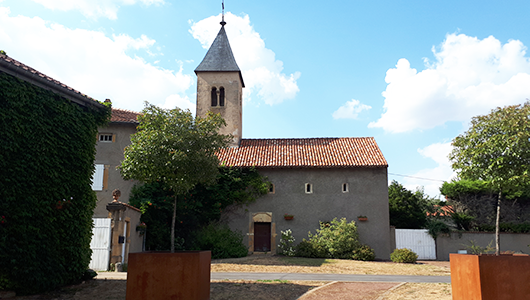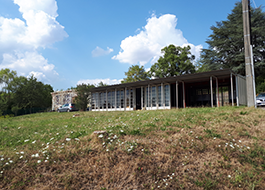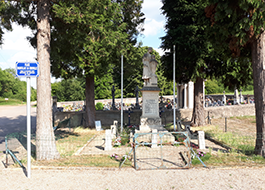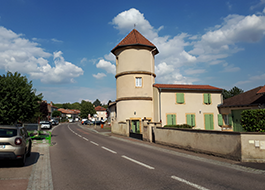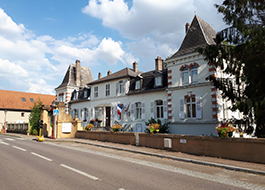Vantoux
Durée visite : 40 minutes
Moyen : Pédestre
Vantoux dépendait de l’ancien Saulnois du pays messin, partagé en quatre bans et seigneuries. Il a constitué un village de repli pour les juifs de Metz avec une synagogue avant 1940. Le surnom de juifs a d’ailleurs été donné aux habitants du village. En 1790, une querelle avec le curé de Mey, dont dépendait Vantoux, a valu comme autre sobriquet celui peu charitable de vermine.
Vantoux depended on the former Saulnois of the Metz region, divided into four bans and seigneuries. It constituted a fallback village for the Jews of Metz with a synagogue before 1940. The nickname of Jews was also given to the inhabitants of the village. In 1790, a quarrel with the cure of Mey, on which Vantoux depended, was worth as another nickname that not very charitable of vermin.
Vantoux war auf die ehemaligen Saulnois der Region Metz angewiesen, die in vier Verbote und Seigneuries unterteilt waren. Es war ein Fallback-Dorf für die Juden von Metz mit einer Synagoge vor 1940. Der Spitzname Juden wurde auch den Bewohnern des Dorfes gegeben. Im Jahr 1790 war ein Streit mit der Heilung von Mey, von dem Vantoux abhing, als ein weiterer Spitzname wert, der für Ungeziefer nicht sehr wohltätig war.

D’azur à l’édifice de trois colonnes. sommé d’un toit fleuronné, mourant d’une terrasse. le tout d’or.
Figuration du célèbre monument appelé « La Croix Louve », sur le ban de Vantoux.
Azure to the building of three columns. topped with a flowered roof, dying from a terrace. all gold.
Representation of the famous monument called « La Croix Louve », on the Vantoux ban.
Azure zum Bau von drei Säulen. gekrönt mit einem blumigen Dach, das von einer Terrasse stirbt. alles Gold.
Darstellung des berühmten Denkmals « La Croix Louve » zum Vantoux-Verbot.

Les noms des habitants de Vantoux s’appellent les Vantousiens et les Vantousiennes.
The names of the inhabitants of Vantoux are called Vantousiens and Vantousiennes.
Die Namen der Einwohner von Vantoux heißen Vantousiens und Vantousiennes.
Les points de visites
.
L’école Prouvé de Vantoux est un bâtiment emblématique unique en France, inscrit à l’inventaire des Monuments Historiques depuis 2001. Elle a été construite en 1950 par un groupement constitué des Ateliers du designer Jean Prouvé et de son frère, à savoir l’architecte Henri Prouvé. L’idée était de pouvoir réaliser en trois mois un établissement scolaire facile et rapide à monter, pour y accueillir des enfants dans le contexte de l’immédiat après-guerre. L’ensemble aux lignes épurées ne dispose pas de fondation, mais repose sur une dalle, quelques murets en béton et environ 70 panneaux amovibles, monoblocs en aluminium de 91 cm de large et de 2,20 mètres de haut. En 2014, ces derniers ont été démontés un par un pour être rénovés dans les ateliers des Métalliers Lorrains, à Nancy. L’intérieur de l’école a également été rénové. Débarrassé des peintures qui le recouvraient, l’aluminium a ainsi retrouvé son aspect originel, tout comme les bois, le parquet stratifié, les fenêtres escamotables, les hublots et les grandes baies vitrées qui s’ouvrent sur la campagne environnante. Les pans de murs extérieurs de l’édifice arborent, quant à eux, désormais une couleur jaune coquille d’œuf et gris foncé qui tire vers le vert olive à l’arrière.
The school Prouvé de Vantoux is an emblematic building unique in France, listed in the inventory of Historical Monuments since 2001. It was built in 1950 by a group made up of the workshops of designer Jean Prouvé and his brother, namely the architect Henri Prouvé. The idea was to be able to build an easy and quick to set up school in three months, to accommodate children in the immediate post-war context. The clean-lined set has no foundation, but rests on a slab, a few concrete walls and around 70 removable, one-piece aluminum panels 91 cm wide and 2.20 meters high. In 2014, these were dismantled one by one to be renovated in the workshops of Métalliers Lorrains, in Nancy. The interior of the school has also been renovated. Freed from the paint that covered it, the aluminum has thus regained its original appearance, as have the woods, the laminate flooring, the retractable windows, the portholes and the large picture windows that open onto the surrounding countryside. The exterior wall sections of the building are now in an eggshell yellow and dark gray color that draws towards olive green at the back.
Die Schule Prouvé de Vantoux ist ein in Frankreich einzigartiges Gebäude, das seit 2001 im Inventar der historischen Denkmäler aufgeführt ist. Sie wurde 1950 von einer Gruppe aus den Werkstätten des Designers Jean Prouvé und seines Bruders, dem Architekten Henri Prouvé, erbaut. Die Idee war, in drei Monaten eine einfach und schnell einzurichtende Schule zu bauen, um Kinder im unmittelbaren Nachkriegskontext unterzubringen. Das klare Set hat kein Fundament, sondern ruht auf einer Platte, einigen Betonwänden und rund 70 abnehmbaren, einteiligen Aluminiumplatten mit einer Breite von 91 cm und einer Höhe von 2,20 Metern. 2014 wurden diese nacheinander abgebaut und in den Werkstätten von Métalliers Lorrains in Nancy renoviert. Das Innere der Schule wurde ebenfalls renoviert. Befreit von der Farbe, die es bedeckte, hat das Aluminium sein ursprüngliches Aussehen wiedererlangt, ebenso wie die Hölzer, der Laminatboden, die versenkbaren Fenster, die Bullaugen und die großen Panoramafenster, die sich zur umliegenden Landschaft öffnen. Die Außenwandabschnitte des Gebäudes haben jetzt eine schalengelbe und dunkelgraue Farbe, die hinten olivgrün ist.
.
.
La création de la taxe Brancas, à laquelle sont assujettis les juifs de Metz à partir de 1716, accentue l’émigration, vers Vantoux notamment. On trouve alors une vingtaine de familles juives à laquelle s’agrègent deux autres de Mey et deux de Vallières. Leur synagogue est édifiée au milieu du 18ème siècle dans une maison particulière, en haut du village, sur le sentier conduisant à Mey. A la fin du 18ème siècle, la communauté compte trente-cinq familles sans compter celles de Mey et de Vallières. Une nouvelle synagogue est construite en 1777 sur un terrain offert gracieusement par le seigneur de Vantoux. Le 31 octobre 1736 devant maître Bernard, notaire à Metz, les juifs de Vantoux, Vallières et Mey achètent à Claude Saget, Seigneur de Vantoux, un terrain situé sur le ban du village pour y aménager un cimetière. La première inhumation daterait de 1739, il s’agit de la dame Sichem, fille du rabbi Meschonlam. En 150 ans, 215 personnes y furent inhumées. En 1830, sur quatre cent cinquante habitants de Vantoux, deux cent onze sont juifs. Ils disposent, outre de leur synagogue, d’une école juive, et appointent un instituteur qui fait aussi office de chantre. La plupart sont marchands de bestiaux et disposent de leur propre abattoir. La synagogue a été désaffectée en 1929. Le monument aux morts voisin représente une femme avec palme.
The creation of the Brancas tax, to which the Jews of Metz were subject from 1716, increased emigration, particularly to Vantoux. There are then about twenty Jewish families to which two more from Mey and two from Vallières belong. Their synagogue was built in the middle of the 18th century in a private house, at the top of the village, on the path leading to Mey. At the end of the 18th century, the community had thirty-five families without counting those of Mey and Vallières. A new synagogue was built in 1777 on land graciously donated by the Lord of Vantoux. On October 31, 1736 in front of Maître Bernard, a notary in Metz, the Jews of Vantoux, Vallières and Mey bought from Claude Saget, Lord of Vantoux, land located on the outskirts of the village to build a cemetery. The first burial would date from 1739, it concerns Lady Shechem, daughter of Rabbi Meschonlam. In 150 years, 215 people were buried there. In 1830, out of four hundred and fifty inhabitants of Vantoux, two hundred and eleven were Jews. In addition to their synagogue, they have a Jewish school, and appoint a teacher who also acts as cantor. Most of them are cattle dealers and have their own slaughterhouses. The synagogue was decommissioned in 1929. The nearby war memorial depicts a woman with a palm tree.
Die Einführung der Brancas-Steuer, der die Juden von Metz ab 1716 unterworfen waren, verstärkte die Auswanderung, insbesondere nach Vantoux. Es gibt dann ungefähr zwanzig jüdische Familien, zu denen zwei weitere aus Mey und zwei aus Vallières gehören. Ihre Synagoge wurde Mitte des 18. Jahrhunderts in einem Privathaus oben im Dorf auf dem Weg nach Mey erbaut. Ende des 18. Jahrhunderts hatte die Gemeinde 35 Familien, ohne die von Mey und Vallières zu zählen. Eine neue Synagoge wurde 1777 auf Land gebaut, das der Herr von Vantoux freundlicherweise gestiftet hatte. Am 31. Oktober 1736 kauften die Juden von Vantoux, Vallières und Mey vor Maître Bernard, einem Notar in Metz, von Claude Saget, Lord von Vantoux, Land am Rande des Dorfes, um einen Friedhof zu bauen. Das erste Begräbnis würde aus dem Jahr 1739 stammen und betrifft Lady Shechem, die Tochter von Rabbi Meschonlam. In 150 Jahren wurden dort 215 Menschen beigesetzt. Im Jahr 1830 waren von vierhundertfünfzig Einwohnern von Vantoux zweihundertelf Juden. Zusätzlich zu ihrer Synagoge haben sie eine jüdische Schule und ernennen einen Lehrer, der auch als Kantor fungiert. Die meisten von ihnen sind Viehhändler und haben ihre eigenen Schlachthöfe. Die Synagoge wurde 1929 stillgelegt. Das nahe gelegene Kriegsdenkmal zeigt eine Frau mit einer Palme.
.
C’est un pigeonnier en forme de tour, comprenant une charpente formée d’un poteau central et d’une échelle tournante, permettant d’atteindre les nids. Celui-ci servait aux allemands pour surveiller la gare de Vantoux en temps de guerre. Parmi les conditions dont il est convenable de tenir compte dans l’établissement d’un pigeonnier , il faut signaler la nécessité qu’il y a de séparer absolument les couples appariés, en donnant à chacun une case distincte, avec issue particulière. C’est le seul moyen d’éviter les batailles et les croisements bâtards. Toutes les cases doivent être facilement accessibles, par l’intérieur surtout, quand le pigeonnier est pour cela suffisamment grand, et les ouvertures doivent être munies de portes à coulisses manœuvrables à volonté.
It is a tower-shaped dovecote, comprising a frame formed by a central post and a revolving ladder, allowing access to the nests. This was used by the Germans to monitor the Vantoux station in times of war. Among the conditions which it is advisable to take into account in the establishment of a dovecote, it is necessary to announce the necessity which there is to separate absolutely the paired couples, by giving each one a distinct box, with particular exit. This is the only way to avoid battles and bastard crossings. All the boxes must be easily accessible, especially from the inside, when the dovecote is large enough for this, and the openings must be fitted with sliding doors that can be operated at will.
Es ist ein turmförmiger Taubenschlag, der aus einem Rahmen besteht, der aus einem zentralen Pfosten und einer drehbaren Leiter besteht und den Zugang zu den Nestern ermöglicht. Dies wurde von den Deutschen genutzt, um die Vantoux-Station in Kriegszeiten zu überwachen. Unter den Bedingungen, die bei der Einrichtung eines Taubenschlags zu berücksichtigen sind, ist es notwendig, die Notwendigkeit anzukündigen, die gepaarten Paare absolut zu trennen, indem jedem ein eigenes Kästchen mit besonderem Ausgang gegeben wird. Nur so können Schlachten und Bastardkreuzungen vermieden werden. Alle Kästen müssen leicht zugänglich sein, insbesondere von innen, wenn der Taubenschlag dafür groß genug ist, und die Öffnungen müssen mit Schiebetüren versehen sein, die nach Belieben bedient werden können.
.
Le château a été construit en 1870, sous l’Annexion, par les Schneider, une riche famille allemande. Le père était officier. On trouve encore ses initiales – B. S. – sur les grilles. Elle y habitera jusqu’à la fin de l’Annexion, en 1919. Yvette Matte qui occupe les anciennes dépendances, se souvient : Ma tante m’a raconté que M. Schneider se déplaçait en calèche. Dans les dépendances, outre son cheval, on trouvait vaches, chèvres, poules, canards ainsi qu’une grande mare. Et aussi un pigeonnier du haut duquel les Allemands surveillaient la gare de Vantoux en temps de guerre. Dans le parc, se trouvaient un élégant bassin ainsi qu’un ancien puits. Lors de la dernière guerre, le château a été habité par des Allemands. Après-guerre, la grande salle située à l’étage a fait office de salle de classe pour les enfants. L’instituteur était Julien Masson, père du sénateur Jean-Louis Masson. En 1951, l’école du château fermait définitivement. Remis en vente en 1960, il a été racheté par Gertrude Rohrbacher qui a occupé l’aile droite. Pour l’aménager à son goût, elle a fait détruire deux marquises ainsi que le majestueux escalier en pierre de l’entrée, qu’elle fera remplacer par deux plus petits. De son côté, Georges Dalbin a acheté et occupé l’aile gauche avec sa famille. En 1988, la municipalité a racheté le château à Mme Rohrbacher pour s’y installer, les locaux de l’ancienne mairie étant devenus trop exigus. Quatre appartements ont été réhabilités et sont loués par la mairie.
The castle was built in 1870, under the Annexation, by the Schneiders, a wealthy German family. The father was an officer. We still find his initials – B. S. – on the gates. She lived there until the end of the Annexation in 1919. Yvette Matte, who occupies the old outbuildings, remembers: My aunt told me that Mr. Schneider used to get around in a horse-drawn carriage. In the outbuildings, in addition to his horse, there were cows, goats, chickens, ducks and a large pond. And also a dovecote from the top of which the Germans watched over the Vantoux station in times of war. In the park, there was an elegant basin as well as an old well. During the last war, the castle was inhabited by Germans. After the war, the large room upstairs served as a classroom for the children. The teacher was Julien Masson, father of Senator Jean-Louis Masson. In 1951, the castle school closed for good. Released in 1960, it was bought by Gertrude Rohrbacher who occupied the right wing. To furnish it to her liking, she had two awnings destroyed as well as the majestic stone staircase at the entrance, which she would replace with two smaller ones. For his part, Georges Dalbin bought and occupied the left wing with his family. In 1988, the municipality bought the castle from Mrs Rohrbacher to settle there, the premises of the old town hall having become too cramped. Four apartments have been rehabilitated and are rented by the town hall.
Das Schloss wurde 1870 unter der Annexion von den Schneiders, einer wohlhabenden deutschen Familie, erbaut. Der Vater war Offizier. Wir finden immer noch seine Initialen – B. S. – an den Toren. Sie lebte dort bis zum Ende der Annexion im Jahr 1919. Yvette Matte, die die alten Nebengebäude bewohnt, erinnert sich: Meine Tante erzählte mir, dass Herr Schneider früher in einer Pferdekutsche herumgefahren sei. In den Nebengebäuden gab es neben seinem Pferd Kühe, Ziegen, Hühner, Enten und einen großen Teich. Und auch ein Taubenschlag, von dessen Spitze aus die Deutschen in Kriegszeiten über die Vantoux-Station wachten. Im Park gab es ein elegantes Becken sowie einen alten Brunnen. Während des letzten Krieges wurde die Burg von Deutschen bewohnt. Nach dem Krieg diente der große Raum im Obergeschoss als Klassenzimmer für die Kinder. Der Lehrer war Julien Masson, Vater von Senator Jean-Louis Masson. 1951 wurde die Schlossschule endgültig geschlossen. Es wurde 1960 veröffentlicht und von Gertrude Rohrbacher gekauft, die den rechten Flügel besetzte. Um es nach ihren Wünschen einzurichten, ließ sie zwei Markisen zerstören sowie die majestätische Steintreppe am Eingang, die sie durch zwei kleinere ersetzen würde. Georges Dalbin seinerseits kaufte und besetzte den linken Flügel mit seiner Familie. 1988 kaufte die Gemeinde das Schloss von Frau Rohrbacher, um sich dort niederzulassen, da die Räumlichkeiten des alten Rathauses zu eng geworden waren. Vier Wohnungen wurden saniert und vom Rathaus gemietet.

